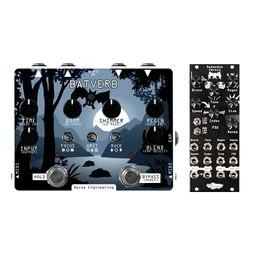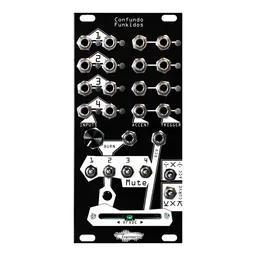Recently, we introduced Imitor Versio, the first delay we have planned for the Versio platform and newest member of the Versio family. IV is a 12-tap delay that is anything but basic. If you’ve already ordered yours, we hope you’ve been enjoying it! If you have a Desmodus Versio and you’d like to try out the Imitor, you’re in luck! The Imitor firmware can be flashed onto any Versio module at the Customer Portal (and flash back to the original -- or any other Versio firmware -- at any time!).
Today we’ll do a deep dive on everything Imitor. Let’s start by looking at the core concepts that make Imitor do its thing.
What is a 12-tap delay?
If you’re not a huge delay nerd, you may not be exactly sure what a multitap delay is, or what it does. If you think of a traditional delay, you’re probably thinking of a single-tap delay: audio runs into a buffer, and you change your controls around to determine where in that buffer you pull a copy out. With a single-tap delay, you get only one repeat; turn up the feedback, you get more and more repeats.

A multitap delay gives you multiple repeats even before you add the feedback in. Think of the audio running into a buffer, again, but now you have a lot of places (taps) where you can pull audio out. Multi-tap delays are common, but most give four or eight taps. We had big ambitions for 16, but we landed on 12 because that is what worked best with our hardware and to our ears. So 12 taps – that means 12 repeats, before you turn the feedback up.

There are then a bunch of parameters on IV that adjust how those repeats sound: they can have their timing and volume adjusted relative to each other, they can be panned in different ways, and then, in the case of IV, they can be run through the feedback loop. There, they can be repeated again, if you’d like, and processed with either a limiter, distortion, or a pitch shifter.
As you can imagine, this leads to sounds and atmospheres that are very different from what you’d get out of a traditional delay.
Learn more:
Now, that sounds pretty cool, if you ask us. But how do the controls on this thing work? Let’s talk about that in a bit more detail. We’re going to talk about the controls in an order that may seem slightly random, but is a good way to learn about the functions of the module; many of the IV parameters are interdependent and build off of each other in interesting ways.
I/O: plug the thing into the thing to do the thing
The IV has 7 CV inputs, a clock input, and a stereo pair of inputs and outputs. At a minimum you’ll need a sound going into the L input (and maybe the R input, too, if your source is stereo. If it’s not, have no fear! IV sounds great with both mono and stereo inputs.), and the L and R outs patched to your mixer. The rest of the inputs can be used to change the delay’s sound and behavior, but you don’t need to do that, especially when you’re first learning IV.
Blend
The Blend parameter is simple, but important: it’s a dry/wet control. Fully counterclockwise, you only get your original signal. Fully clockwise, you only get the delay signal. Anywhere in between you’ll get a mix of both. This is useful for creating a nice balance between your echoes and the sound you’re echoing.
Regen
Regen is the feedback control. This is, arguably, the most important control on IV: it controls how long the delay tail is, and past 3:00 on the knob, it ducks the delay based on the input signal, so you can do some sidechain compression effects in the module itself. And, similar to Desmodus Versio, it can create infinite feedback with delay tails that go on forever.
Time and Spread
Time and Spread are the main timing controls for IV and are highly dependent on each other. Spread controls the total amount of time the 12 taps take from a sound being input to the last tap playing. Time is similar to a predelay: it offsets the time between a sound being input and the first tap playing. It also squishes the taps into the remaining amount of time, so a longer predelay means faster tap firing since they occupy a smaller amount of the total time.
These controls can also be clocked, and act as clock dividers/multipliers when dealing with a tapped-in tempo or a clock input.
Skew
Skew is a fun control: it lets you set an amount of acceleration or deceleration for the delay taps. It’s also bipolar, meaning the “off” is in the middle. In the center, the tap timing is equal. To the left, taps start fast and get slower. To the right, taps start slow and get faster. This is a great control for making bouncing ball effects or just adding a little bit of variation to the delay timing.
>=<
The bottom switch on IV controls the volume of the 12 taps: equal in the center, a decrescendo to the left, and a crescendo to the right. You can use the crescendo setting, for instance, to create “reverse” delays, with dynamics that are the opposite of a traditional delay. Or, you can use the decrescendo to create something like that bouncing ball effect we mentioned in the Skew section. = is probably my favorite when I’m making delays with high Regen settings, because of how massive the delay tail gets -- what can I say, I like giant walls of sound.
LIM DST SHM
The top switch on IV will be familiar to Desmodus fans, mostly because, well, it’s the same switch as is featured on the Desmodus. This switch changes how the feedback loop on IV is processed: in LIM mode, a clean limiter is applied, which doesn’t change much in terms of tone of the delay. DST mode, however, adds a distortion to the feedback loop, giving you some pretty gnarly tones with high Regen settings. And finally, SHM adds a +1 octave pitch shift to the loop, so you can get some nice pitch-shifted delays going. Who says delays can’t be pretty, too??
Angle
Angle offsets the taps from each other in the stereo field. It’s another bipolar control: In the center, all the taps stay in the same stereo position. As you move it left or right, each tap will be offset by that amount and in that direction from the previous tap. You can create subtle stereo effects with low settings, or you can make sounds bounce all over the place by really cranking it.
LFO
This is the main tone-shaping parameter on IV: it adds filtering and modulation to the delay lines, massively changing their flavor. The filter is a slightly resonant and extremely wide bandpass filter. Traditional delays, like ones based on tape or BBDs, don’t perfectly repeat the input signal: they tend to filter and shape the sound before repeating it, and this control lets you add in some of that not-perfect-and-totally-awesome flavor.
LFO is bipolar, so you get a pretty clean delay line with LFO centered. To the left, mild and random modulation is added to the delay lines. To the right, the modulation is a triangle LFO. And since it’s a resonant filter, at the extremes, it can oscillate on its own just a little bit and create some really interesting effects (referred to affectionately here at NE as the bees and whales. We do like our animals.).
Tap
The tap button on the IV has a lot under the hood, and can be used for multiple functions. Use Tap to tap in the tempo of the delay, or send a clock to the Tap jack to sync your delay to an external clock source.
That’s not all it does, though: if you want to go back to the internal IV clock, unpatch your clock from the Tap jack (if you’re using one) and hold down the Tap button until the LEDs flash orange. Then you’re back to delay time being completely controlled by Spread and Time.
And if you hold down the Tap button even longer, the LEDs flash white and the feedback loop is cleared completely. This is useful, especially while you’re learning how the IV works, as it lets you start over with a clear delay and try something new.
Sometimes modules are cursed: looking back on IV’s development
We knew that we wanted to make a delay, but ironing out the details took some time, and squashing all the bugs took even longer.
And then we found out IV was cursed. Such is life.
We had toyed with the concept of a delay for a long, long time, but while we were making the Desmodus Versio, we realized that we had the opportunity to do something really cool and put a lot of firmwares on this single hardware. We hit pause and thought carefully about the circuitry as it would have to be able to sustain a lot of different designs. This rethink is part of the reason DV took as long as it did to get into the world. But that was just the beginning. When we realized the delay would fit on DV, the floodgates opened and we repurposed a ton of our ideas to fit into the Versio concept and were at last count at 26 potential firmwares. We also needed a way for users to be able to manage this and choose what firmware they wanted to put on their hardware. So we put Ankoor to work on what is now our Customer Portal where people can try any firmware out, and swap out as they like.
But back to the IV. Initially, we wanted to make IV a 16-tap delay, instead of a 12. The first version of the IV had 16 taps, but it just didn’t perform quite how we wanted it to, and we decided to opt for quality over quantity and drop the number of taps. We tried 8, but it wasn’t enough, so we split the difference and went for 12. Twelve still allowed for the performance we wanted but wasn’t as sparse as 8 and gave the results we’d been hoping for.
Once we ironed out the details, we dove headfirst into development… which is when we discovered the curse of IV. First, the panels came back wrong: the first batch of panels we ordered when we thought we could go into production came back with unexplainable issues and we had to reprint at the last minute [ed. note: by unexplainable, Markus means there was a typo in the file that somehow ALL OF US missed]. Then, we sent a preproduction proto that we hadn’t tested well to Patrick O’Brien so he could film the demo video for it, but one of the audio jacks didn’t work very well. Stephen went to drop a replacement unit on POB’s porch… but on the way his tire blew and he had to go get four new tires, making this the most personally expensive module we’ve made.
During test, Kris hadn’t actually played with IV much as she was swamped with other things, so that was left to the rest of the team. The night before launch, she plugged it in for the first time and IMMEDIATELY found a reasonably large but hard-to-reproduce bug. We rushed to patch it in time for the firmware to go public before the release deadline.
Basically, be careful when you’re using IV: it’s a little bit evil and maybe definitely a lot cursed. Maybe it’s got something to do with that pyramid on the panel?
So, now you’ve heard the IV, and read about what it can do, and learned about its, um, interesting history. If you want to get it in yer rack, you can order it at our shop: they’re available and shipping now! Remember, Versio modules are a platform, meaning that if you own one, you own them all. The Desmodus, Ampla, and Imitor firmwares are available now, with many more on the way. Flash any of them to your Versio module from the Customer Portal. Change the firmware as often as you like. Get panel printouts, replacement panels, manuals, patchbooks, and more at our World of Versio page.






